Smart Fit Bundle
Who Really Owns Smart Fit?
Unraveling the Smart Fit SWOT Analysis is just the beginning! Understanding the Smart Fit ownership structure is crucial to grasping its strategic direction and future potential. This deep dive explores the key players behind Latin America's leading gym chain, from its humble beginnings to its current global presence. Knowing who owns Smart Fit is essential for any investor or business strategist.
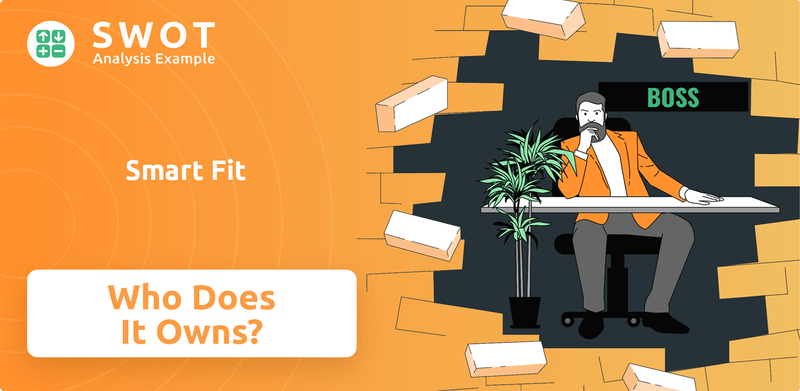
From its Smart Fit headquarters in São Paulo, Brazil, to its expansive network across 15 countries, the Smart Fit company has transformed the fitness landscape. This analysis will examine the Smart Fit company ownership, including the influence of its Smart Fit CEO and other key executives, providing a comprehensive view of its financial health and strategic positioning. Discover the Smart Fit history and its journey to becoming a global leader.
Who Founded Smart Fit ?
The story of Smart Fit begins in 1996, with the establishment of the Bio Ritmo gym, marking the company's initial foray into the fitness industry. The founding and early ownership of the company are intrinsically linked to the Corona family, particularly Edgard Corona, who serves as the CEO and founder. His vision played a crucial role in shaping the company's early trajectory and its subsequent growth into a major player in the fitness market.
While the precise initial ownership structure and equity splits among the founders aren't publicly detailed, the Corona family has consistently maintained a significant controlling stake. This strong familial ownership has been a constant as the company expanded. The company's evolution showcases how a family-led business can achieve significant market presence and influence.
In 2009, the company pioneered the High Value Low Price (HVLP) model in Latin America, launching the first Smart Fit gyms in Brazil. This strategic shift aimed to broaden the appeal of fitness, making it more accessible to a wider audience. The early stages of the company's expansion were also supported by initial investors, though specific details about these early backers remain limited in public records. The adoption of the HVLP model was central to the company's expansion and market dominance.
The ownership structure of Smart Fit, particularly who owns Smart Fit, is primarily centered around the Corona family, especially Edgard Corona, the CEO and founder. The company's early growth was influenced by the family's vision and strategic decisions.
- Founding: The company's inception dates back to 1996 with the establishment of the Bio Ritmo gym.
- Family Leadership: The Corona family, with Edgard Corona at the helm, has been central to the company's ownership and management.
- Strategic Shift: In 2009, the company adopted the High Value Low Price (HVLP) model, expanding its reach.
- Market Presence: The company has grown to have a significant market share.
Smart Fit SWOT Analysis
- Complete SWOT Breakdown
- Fully Customizable
- Editable in Excel & Word
- Professional Formatting
- Investor-Ready Format
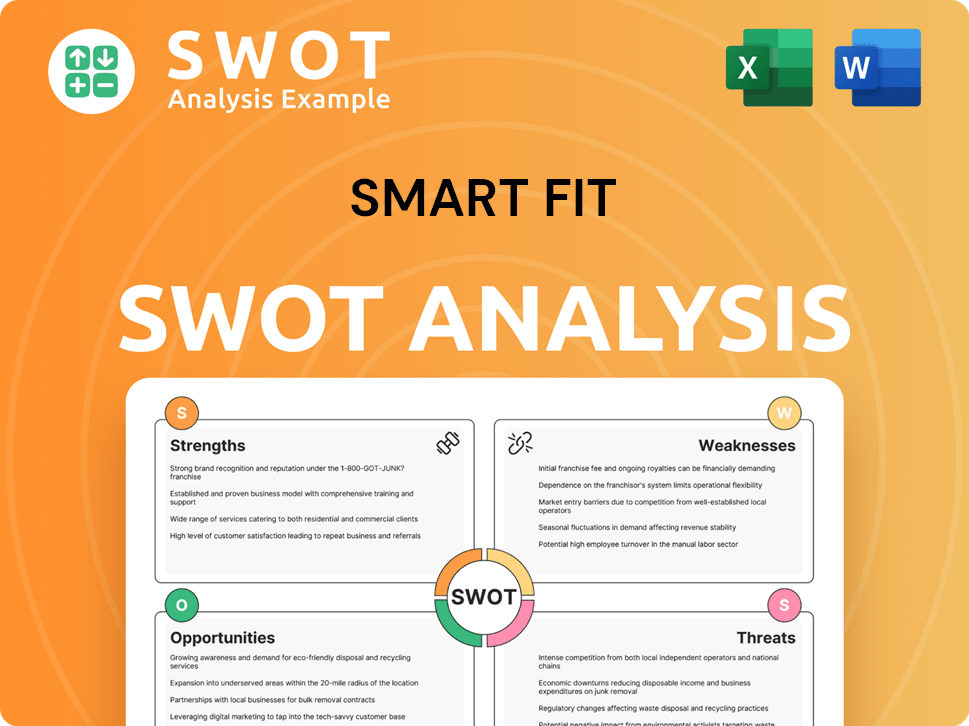
How Has Smart Fit ’s Ownership Changed Over Time?
The ownership structure of the fitness company, has changed significantly since its inception. A key event was its initial public offering (IPO) in 2021, which raised BRL 2.6 billion. This event marked a pivotal shift, transforming the company into a publicly traded entity and allowing for substantial capital infusion to fuel its expansion strategies. The company's evolution reflects strategic decisions aimed at growth and market penetration, especially across Latin America. The IPO was a crucial step in shaping the current ownership landscape.
The company is listed on the BVMF stock exchange under the ticker SMFT3. As of June 10, 2025, the market capitalization stood at $2.64 billion, with approximately 597 million shares outstanding. This is a notable increase from its market cap of $2.124 billion as of November 19, 2024. This growth highlights the company's performance and the confidence of investors in its future. Understanding the evolution of the company's ownership is crucial for assessing its strategic direction and financial health.
| Date | Event | Impact on Ownership |
|---|---|---|
| 2021 | IPO | Public listing, capital infusion |
| November 2019 | CPPIB Investment | CPPIB acquired a 12.4% stake |
| Ongoing | Stakeholder Management | Corona family and Patria Investimentos maintain significant influence |
Currently, the major stakeholders in the company include the Corona family, holding a 14.8% stake, and Patria Investimentos, with a 30.1% stake. These two entities jointly control the company. Another significant investor is Canada Pension Plan Investment Board (CPPIB), which owns 12.1% (as of August 2024). The Singaporean sovereign wealth fund GIC holds an 8.2% stake. These key investors significantly influence the company's strategic direction and governance. For more insights into the company's consumer base, consider exploring the Target Market of Smart Fit .
The company's ownership structure is a mix of founder control and institutional investment.
- The Corona family and Patria Investimentos jointly control the company.
- CPPIB and GIC are also major institutional investors.
- The IPO in 2021 was a major event in the evolution of the company.
- The company's market cap as of June 10, 2025, was $2.64 billion.
Smart Fit PESTLE Analysis
- Covers All 6 PESTLE Categories
- No Research Needed – Save Hours of Work
- Built by Experts, Trusted by Consultants
- Instant Download, Ready to Use
- 100% Editable, Fully Customizable
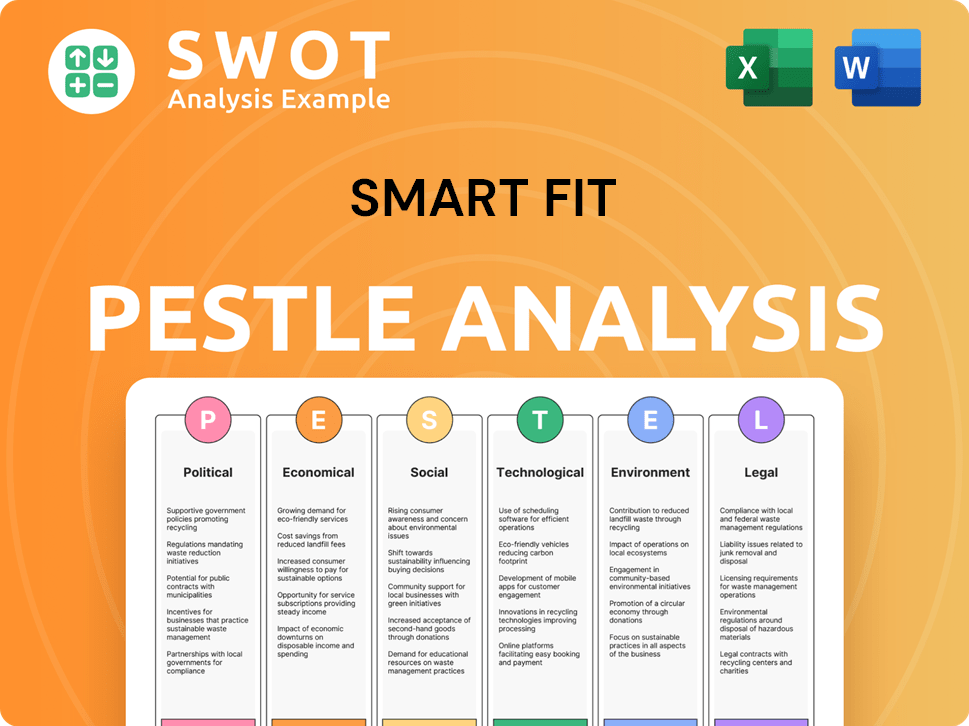
Who Sits on Smart Fit ’s Board?
The Board of Directors of the Smart Fit company oversees the company's general business policies and long-term strategy. The board consists of nine members, elected by the general shareholders' meeting for a unified term of two years, with the possibility of re-election. At least two or 20% of the board members, whichever is greater, must be independent advisors, as defined by the New Market Regulation. The chairman of the Board of Directors is appointed by the General Shareholders' Meeting.
As of the Ordinary General Shareholders' Meeting on April 25, 2024, Ms. Cláudia Elisa de Pinho Soares, Mr. Wolfgang Stephan Schwerdtle, and Mr. Ricardo Lerner Castro were approved as independent members of the Board. This composition ensures a degree of independent oversight in the company's governance structure. The board's decisions are approved by a simple majority vote of its members.
| Board Member | Role | Independent |
|---|---|---|
| Cláudia Elisa de Pinho Soares | Independent Board Member | Yes |
| Wolfgang Stephan Schwerdtle | Independent Board Member | Yes |
| Ricardo Lerner Castro | Independent Board Member | Yes |
| Remaining Board Members | Various | Varies |
The joint control by the Corona family (14.8% stake) and Patria Investimentos (30.1% stake) indicates a significant concentration of voting power, influencing the strategic direction of the Smart Fit company. This ownership structure is key to understanding the Smart Fit ownership and the company's governance. There is no readily available information on recent proxy battles, activist investor campaigns, or governance controversies.
Understanding the board's composition and the major shareholders is crucial for assessing the Smart Fit company ownership structure. The board's independence and the voting power distribution are key factors in the company's strategic direction.
- The board has 9 members.
- At least 2 or 20% of the board must be independent.
- The Corona family and Patria Investimentos have significant voting power.
- Board decisions are made by a simple majority vote.
Smart Fit Business Model Canvas
- Complete 9-Block Business Model Canvas
- Effortlessly Communicate Your Business Strategy
- Investor-Ready BMC Format
- 100% Editable and Customizable
- Clear and Structured Layout
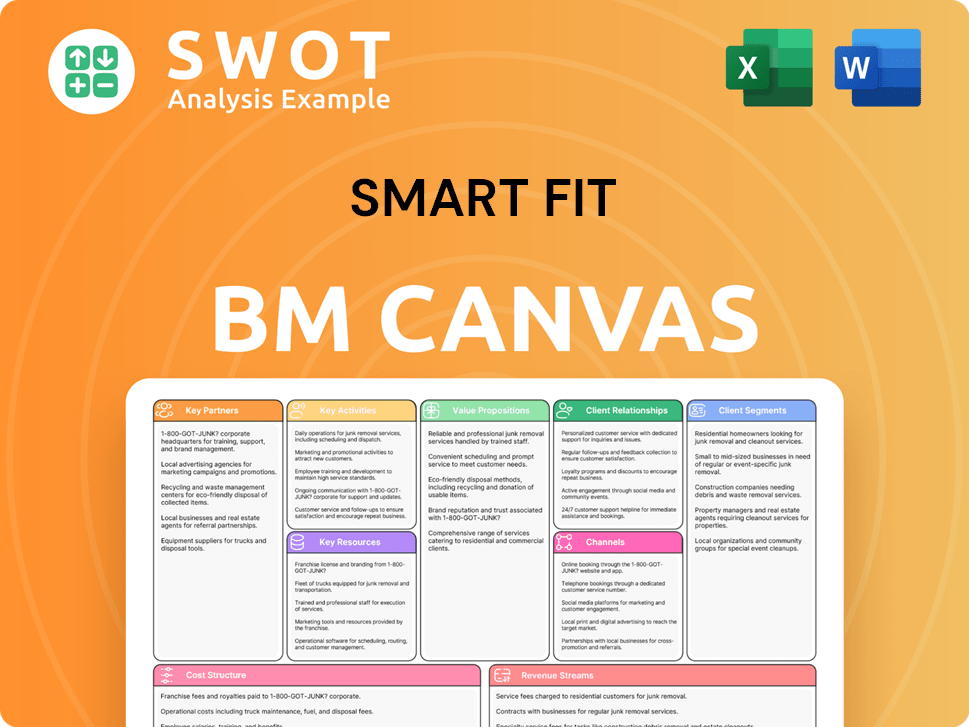
What Recent Changes Have Shaped Smart Fit ’s Ownership Landscape?
Over the past few years, the focus on Smart Fit ownership has been marked by significant strategic moves. The company, a major player in the Latin American fitness market, has demonstrated an aggressive expansion strategy. This includes opening new locations and making acquisitions to strengthen its market position.
In 2024, the company's expansion was substantial, with 305 new locations added, bringing the total to 1,743 gyms across 15 Latin American countries. This represents a 21% increase from 2023. Furthermore, the acquisition of Velocity Group in 2024, with an initial payment of R$163 million ($28.6 million), indicates a move to diversify its offerings in the specialized fitness sector. The Administrative Council for Economic Defense (CADE) in Brazil approved this acquisition in October 2024.
| Metric | 2023 | 2024 |
|---|---|---|
| Net Revenue (R$ billions) | R$4.27 | R$5.58 |
| EBITDA (R$ billions) | R$1.38 | R$1.8 |
| Net Debt (R$ billions) | R$1.38 | R$2.99 |
| Number of Gyms | 1,438 | 1,743 |
| Number of Members (millions) | 4.5 | 5.2 (end of 2024), 5.5 (January 2025) |
The company's financial performance in 2024 saw net revenue reach R$5.58 billion ($930 million), a 31% increase from 2023. For Q1 2025, sales were BRL 1,678.17 million, compared to BRL 1,259.89 million a year ago, with net income of BRL 120.52 million. Despite strong revenue growth and a record EBITDA of R$1.8 billion in 2024, the company experienced a decline in profit, primarily due to expansion costs and higher financial expenses. The company also approved a share repurchase program in November 2024, allowing the repurchase of up to 16,130,245 shares, representing 5% of its outstanding shares, over an 18-month period ending May 19, 2026.
To understand the company's trajectory, a Brief History of Smart Fit can provide valuable insights into its origins and evolution.
The global smart fitness market is experiencing significant growth, expanding from $21.12 billion in 2023 to $26.71 billion in 2024. This growth is driven by increasing health consciousness and demand for personalized fitness.
Smart Fit plans to leverage local debt markets for future expansion, with no immediate plans for additional equity fundraising. It is also focusing on digital platforms, such as a marketplace for personal trainers in its app.
The company's focus on expanding its physical presence and enhancing its digital offerings, such as a planned fitness social network for 2025, aligns with the evolving trends in the fitness industry.
Smart Fit Porter's Five Forces Analysis
- Covers All 5 Competitive Forces in Detail
- Structured for Consultants, Students, and Founders
- 100% Editable in Microsoft Word & Excel
- Instant Digital Download – Use Immediately
- Compatible with Mac & PC – Fully Unlocked
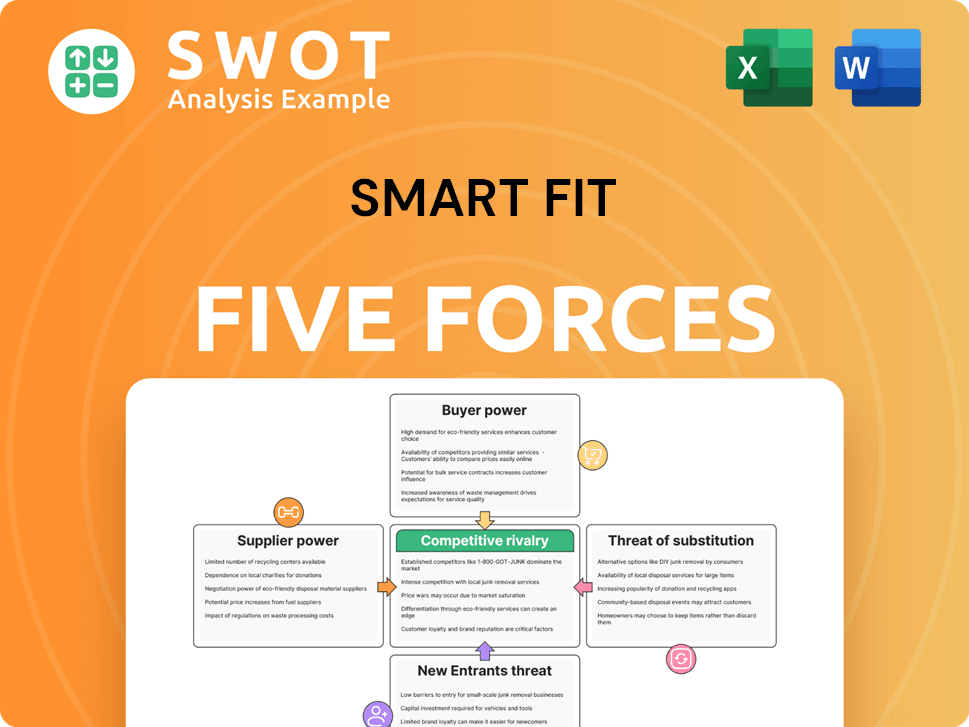
Related Blogs
- What are Mission Vision & Core Values of Smart Fit Company?
- What is Competitive Landscape of Smart Fit Company?
- What is Growth Strategy and Future Prospects of Smart Fit Company?
- How Does Smart Fit Company Work?
- What is Sales and Marketing Strategy of Smart Fit Company?
- What is Brief History of Smart Fit Company?
- What is Customer Demographics and Target Market of Smart Fit Company?
Disclaimer
All information, articles, and product details provided on this website are for general informational and educational purposes only. We do not claim any ownership over, nor do we intend to infringe upon, any trademarks, copyrights, logos, brand names, or other intellectual property mentioned or depicted on this site. Such intellectual property remains the property of its respective owners, and any references here are made solely for identification or informational purposes, without implying any affiliation, endorsement, or partnership.
We make no representations or warranties, express or implied, regarding the accuracy, completeness, or suitability of any content or products presented. Nothing on this website should be construed as legal, tax, investment, financial, medical, or other professional advice. In addition, no part of this site—including articles or product references—constitutes a solicitation, recommendation, endorsement, advertisement, or offer to buy or sell any securities, franchises, or other financial instruments, particularly in jurisdictions where such activity would be unlawful.
All content is of a general nature and may not address the specific circumstances of any individual or entity. It is not a substitute for professional advice or services. Any actions you take based on the information provided here are strictly at your own risk. You accept full responsibility for any decisions or outcomes arising from your use of this website and agree to release us from any liability in connection with your use of, or reliance upon, the content or products found herein.